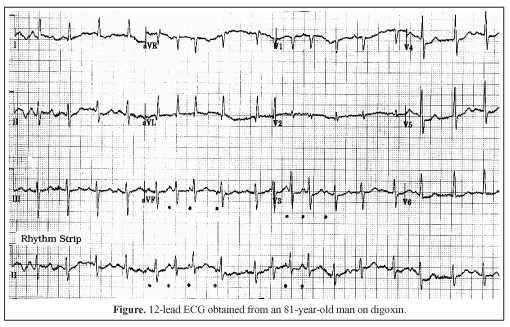ECG Review: Digoxin Use in this 81-Year-Old Man?
October 1, 2002
By Ken Grauer, MD
 |
Clinical Scenario: The ECG shown in the Figure was obtained from an 81-year-old man who presented with heart failure and pneumonia. Digoxin was among his many medications. Why do you suppose he was on digoxin?
Interpretation: Interpretation of the ECG in the Figure is made difficult by the presence of artifact in the baseline. One might be tempted to assume that the irregularly irregular rhythm seen in the lead II rhythm strip at the bottom of this tracing reflects atrial fibrillation. However, close inspection of the rhythm strip suggests that despite baseline wander and artifactual markings, there probably is atrial activity in this lead II rhythm strip. Directing one’s attention to the deflections occurring just above the dots in the rhythm strip suggests the presence of different shaped P waves with varying PR intervals. That these deflections are likely to be real and true manifestations of atrial activity rather than artifact is suggested by confirmation in other simultaneously recorded leads of the presence of P waves. (See dots in leads aVF and V3.)
Thus, this is an irregularly irregular supraventricular (narrow-complex) rhythm with multiple differently shaped P waves—a description that strongly suggests multifocal atrial tachycardia (MAT) as the etiology of the rhythm.
MAT most often occurs in the setting of chronic pulmonary disease. It is also sometimes seen in the presence of multisystem disease (such as pneumonia, sepsis, acid-base disturbance, or electrolyte disorders). The treatment of choice is to identify and correct the underlying medical cause(s) of the rhythm. One wonders if this 81-year-old man with heart failure mistakenly may have been placed on digoxin for heart failure and misdiagnosis of his irregular rhythm as atrial fibrillation.
Dr. Grauer, Professor and Associate Director, Family Practice Residency Program, Department of Community Health and Family Practice, College of Medicine University of Florida, Gainesville, is on the Editorial Board of Emergency Medicine Alert.